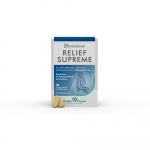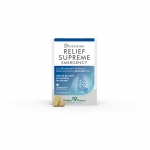Ours is a holistic approach that does not hinder the physiological processes of the body. It's an approach that encourages the restoration of balance, by combatting the causes of symptoms as efficiently as possible and ensuring fast relief.
Symptoms and relief
SELECT YOUR NEED

Osteoarticular and muscular system
INFLAMMATION AND PAIN
INFLAMMATION is an adaptive response to anything that our body perceives as potentially harmful.
Clinically, the tell-tale signs of inflammation are:
- warmth in the inflamed area
- redness
- swelling
- pain and functional impairment
These symptoms frequently affect the musculoskeletal system, thus creating localized tension in the muscles, tendons and bones.


Inflammation develops through complex biochemical processes involving the targets of inflammation, in which molecular and cellular components that are closely interconnected form part, such as:
- The arachidonic acid cascade
- ROS and RNS
- The complement system
- The endocannabinoid system
- Glucocorticoid receptors
WHAT IS PAIN?
Pain is the means by which the body signals damage to its tissues. As defined by the IASP (International Association for the Study of Pain - 2020) and the World Health Organization, pain is "an unpleasant sensory and emotional experience associated with (or similar to that associated with) potential or ongoing tissue damage."
It can be one of two types:
- Acute pain, which appears suddenly; its possible causes include an illness, trauma (e.g., an injury while playing sports) or inflammation of a tissue in the body (such as pain associated with a muscle strain). Its duration is limited in time; when the discomfort lasts for more than 12 weeks, it is classified as chronic pain.
- Chronic pain may result from an initial trauma (e.g., a fall on one's shoulder), which ends up having long-term consequences, or it may be caused by a persistent condition (e.g., chronic degenerative conditions such as arthritis).
Some types of pain:
| TYPE OF PAIN | THE MOST COMMON | SYMPTOMS |
| Acute pain |
|
|
| Chronic pain |
|
|
WHAT IS THE DIFFERENCE BETWEEN INFLAMMATION AND PAIN?
Pain and inflammation are two different things, but they actually have many things in common. To be specific, in most cases, the pain we experience in one part of the body, whether the head (headache), a muscle (myalgia), or somewhere else, is often caused by an underlying inflammation.
Carpal Tunnel Syndrome is one of the most common neuropathies, most prevalent among women over 40 years of age. The carpal tunnel is a canal present at the level of the wrist. Three sides of it are formed by the carpal bones, and the fourth, corresponding to the palm, is formed by the retinaculum of the flexors and the transverse ligament of the carpus. All the structures coming from the forearm that are necessary for the hand pass through the carpal tunnel: nerves, tendons and blood vessels.
Carpal Tunnel Syndrome originates when the median nerve, the nerve that connects the hand with the brain and thus enables finger movements, the perception of pain and temperature and controls palm sweating, is compressed within the carpal tunnel. The causes that lead to this compression are both occupational (repeated and prolonged movements for many hours, incorrect shoulder and arm posture, use of the computer mouse and keyboard) and traumatic events (injuries, sprains).
Furthermore, issues that may be associated with Carpal Tunnel Syndrome can be encountered both systemically and in certain physiological conditions such as diabetes mellitus, rheumatoid arthritis, amyloidosis, hypothyroidism, acromegaly, high blood pressure, renal failure, fungal infection, pregnancy, the use of oral contraceptives, premenstrual syndrome, menopause, deforming arthritis and arthrosis, etc. As a result of one or more of these causes, there is increased pressure within the carpal tunnel, which, combined with the stretching of tendons and nerves, leads to the establishment of inflammation of the flexor tendon bursa (tenosynovitis). The size of the carpal tunnel decreases and the median nerve is compressed.
The typical symptoms begin with a burning and tingling sensation in the hand, especially at the level of the first three fingers. As the disorder progresses, it also causes numbness and swelling of the hand and pain that is especially acute at night and in the morning, and can extend to the elbow. If neglected, this chronic inflammation leads to loss of feeling in the fingers and loss of strength in the entire hand.

